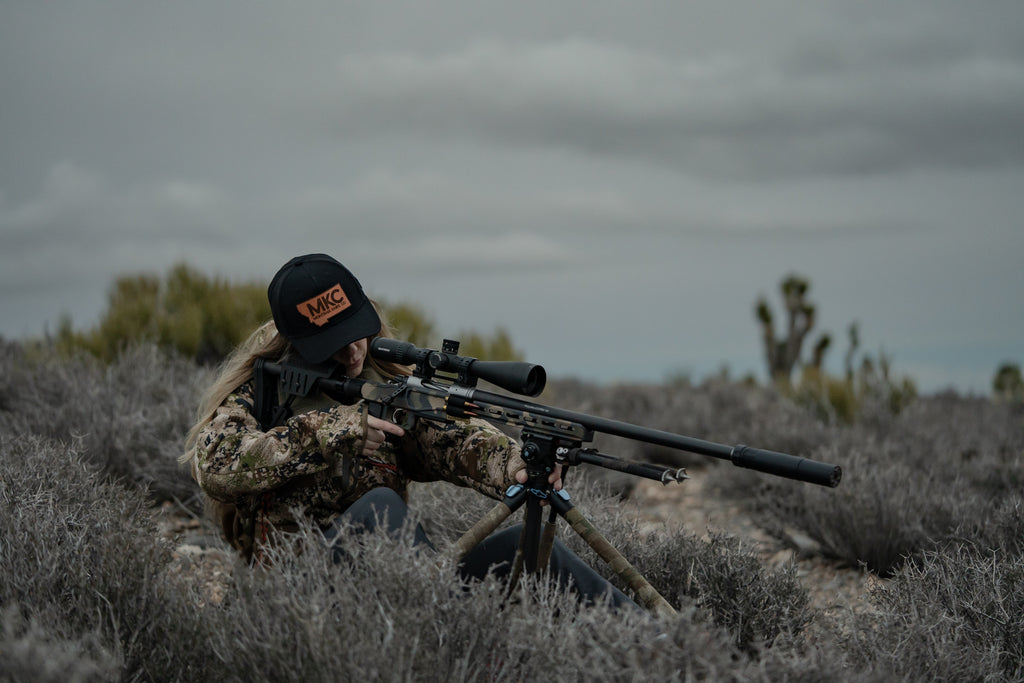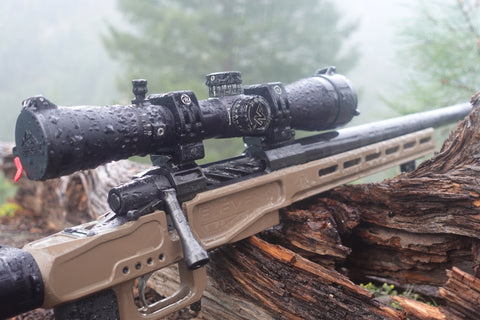Quick Summary
- Introduction: An overview of the critical aspects of hunting, focusing on the importance of selecting the appropriate rifle setup tailored to the game being hunted
- Shooting Positions: How shooting positions (prone, kneeling, standing, sitting) impact rifle choice and setup, along with tips on customizing rifle ergonomics to improve comfort and accuracy in the field.
- Supports: A review of shooting supports like bipods, monopods, and natural rests to improve shooting stability and precision.
- Tips for Perfecting Your Shooting Position: Practical advice on enhancing shooting accuracy and stability through breathing techniques, trigger control, and targeted practice routines.
Importance of Proper Rifle Shooting Positions
The importance of selecting the correct shooting position cannot be overstated in precision shooting. Better yet, overcoming different scenarios when forced to shoot from any position is even better. The choice of position not only determines the stability of the shot but also plays a pivotal role in achieving accuracy and extending the ethical range of a marksman in the field. As we explore the factors influencing the decision on shooting positions, considerations such as range, terrain, and the gear you will have on that hunt – come into play. An often overlooked yet crucial aspect is the proximity to the ground, emphasizing the significance of being as low as possible to enhance stability.
Additionally, the time it takes to construct a shooting position with the chosen gear becomes a critical factor. While tripods offer exceptional stability, they can be time-consuming, especially in dynamic scenarios. On the other hand, bipods excel in prone positions but present challenges when transitioning from a prone stance. Navigating these considerations is pivotal for marksmen as we delve into the nuanced world of shooting positions and gear choices to optimize accuracy and effectiveness in the field.
4 Different Rifle Shooting Positions
Successful shooters understand the importance of adapting to different scenarios. The four shooting positions offer varying levels of stability and support, allowing you to make precise shots from diverse angles and in various terrains. Learning these positions will increase your versatility as a marksman.

The Prone Position
The prone shooting position stands as the epitome of stability and precision in marksmanship. When time permits and the luxury of even terrain allows, opting for the prone position supplies you with the utmost accuracy. To assume the prone position, one lies flat on their stomach with legs spread shoulder-width apart, forming a solid foundation. This position provides optimal support for the rifle, as the elbows rest directly beneath the firearm. While the prone position offers exceptional stability, ensuring a steady shot, it has limitations, notably in terrain with uneven elevations or obstacles. Nevertheless, the advantages of heightened accuracy and minimized shooter movement make the prone position a fundamental technique for shooters seeking precision and control in their shots.
- Pro Tip: Practice shooting from the prone, both supported and unsupported. Unsupported means only using your arms while lying prone to stabilize the rifle, which can still be very stable for fast engagements. Supported means using equipment such as bipods, tripods, shooting sticks, trekking poles, and a backpack.
The Standing Position
The standing shooting position is a dynamic and versatile technique tailored for scenarios demanding quick and immediate action. In situations where time is of the essence or when shooters need to engage targets over obstacles like grass or brush, the standing position becomes a go-to choice. Like all of these positions, there is supported and unsupported standing. Traditional unsupported is commonly for fast engagements at closer ranges when you do not have time to resort to anything else. While supported, they will utilize a tripod, shooting sticks, nearby tree limbs, or even bracing up against something if applicable.
- Unsupported Standing - To assume this shooting stance, shooters stand with their feet shoulder-width apart, maintaining a balanced posture and the body almost parallel to the target. The shooter's back will commonly be slightly bent/arched, and the core muscles engaged, giving the upper body some rigidity. Try to keep your head level; in this position, misalignment of the dominant eye and scope can easily get off plane, causing accuracy and parallax issues. The recoil pad of the buttstock will typically be positioned higher up on the shooter's shoulder and torso, which can cause minimal contact and recoil management issues. With an adjustable buttstock like theTR-2 and C-6 Buttstock, fitment can be more comfortable in the standing position.
- Supported Standing - Especially with the advancements of modern shooting tripods, standing can become a very lethal position, even at some distance! When using equipment like shooting tripods or shooting sticks, the shooter will have their feet at or farther than shoulder-apart and position their body square to the rifle, more like the prone position. This will allow you to position the buttstock more, like when shooting prone or off a bench, and allow them to manage the recoil much better than unsupported. So spotting those farther shots and having fast follow-up shots are a breeze when equipment is allowed to be set up.
While the standing position offers speed and agility, it comes at the cost of reduced stability compared to prone alternatives. The challenge lies in maintaining control and accuracy in a position where the body is more susceptible to movement. Despite its inherent instability, the standing position remains an essential skill for marksmen who must adapt swiftly to unpredictable environments, showcasing the importance of mastering a range of shooting techniques.
The Kneeling Position
The kneeling shooting position is a valuable compromise between the stability of the prone position and the agility of standing. This position is particularly useful when shooters need to engage targets over shorter obstacles, and going prone is not feasible. To assume the kneeling position, one kneels on one knee with the other foot flat on the ground, providing a solid foundation for the upper body. Supporting the rifle with an elbow-to-knee contact enhances stability, allowing for more accurate shots compared to standing. While the kneeling position offers a quicker setup than sitting, it requires practice to master and may pose challenges if not executed correctly. This shooting position is an excellent choice for marksmen navigating terrain that demands a balance between stability and the need for a rapid response, showcasing its versatility in various shooting scenarios.
The Sitting Position

The sitting shooting position offers a stable platform for marksmen when engaging targets over shorter obstacles, striking a balance between the versatility of standing and the stability of prone. In the sitting position, shooters can choose to sit with their legs crossed or spread, providing a grounded base for the upper body and the rifle. This stance is particularly advantageous in scenarios where lying prone is not an option, but stability is still crucial. However, the sitting position tends to be slower to assume compared to standing or kneeling, requiring careful practice to master efficiently. Despite its potential drawbacks, the sitting position remains a valuable tool in a marksman's toolbox, offering a reliable compromise between stability and adaptability in diverse shooting environments.
Supports for Rifle Shooting

Various support systems play a crucial role in enhancing stability and accuracy across different shooting positions, providing marksmen with adaptable solutions for diverse scenarios. Bipods are particularly favored for their stability, firmly grounding the rifle and minimizing recoil. Tripods, with their three-legged competitor, offer a higher degree of versatility, especially when integrated with an Arca rail like you find on the XLR chassis systems. This integration allows for quick adjustments and precise control, contributing to enhanced stability and accuracy. Monopods, providing single-point support, are valuable for situations demanding a balance between stability and mobility. Additionally, shooting sticks offer a portable and adjustable support option. In certain outdoor environments, marksmen can also leverage natural supports such as trees and logs to stabilize their rifle.
These various support systems cater to the unique demands of different shooting positions, ensuring that marksmen can maintain control and accuracy across a spectrum of scenarios.
Tips for Perfecting Your Shooting Position
Achieving precision and consistency in marksmanship extends beyond mastering shooting positions; it involves honing fundamental techniques for optimal performance. When assuming a kneeling or sitting position, prioritizing bone support is essential. This involves creating a hard-to-soft contact, such as placing the elbow on the thigh while sitting or the knee against the triceps while kneeling. This configuration establishes the most stable foundation for accurate shots.
Additionally, incorporating controlled breathing techniques is crucial for maintaining focus and reducing shooter-induced movement. Perfecting trigger control is another vital aspect, emphasizing the importance of a smooth squeeze through the entire shot process, even if the reticle isn't perfectly steady. Lastly, practicing with purpose is key to continual improvement. Instead of aimless sessions, marksmen should set clear training goals, focusing on specific elements like tripod shooting, navigating uneven terrain, or rapidly building a shooting position. This deliberate approach ensures targeted improvement and a steady progression in marksmanship skills.
Master Your Marksmanship and Explore XLR Rifle Chassis
In conclusion, our exploration into precision shooting techniques covers the significance of selecting the appropriate shooting position. This decision not only governs the stability of a shot but fundamentally shapes the precision and ethical boundaries of a marksman in the field. Taking into account variables such as target range, topography, and carried equipment assumes paramount importance. Our discourse on support systems, such as bipods and tripods, highlights their versatile utility across diverse shooting contexts. Some modern equipment for your hunting rifle, like a precision chassis from XLR Industries, allows fitting and adapting to support systems, as mentioned, easier than traditional stocks. To finish our discussion, we emphasized foundational skills like optimizing bone support, employing controlled breathing techniques, and exercising discerning trigger control. Deliberate and purposeful practice in honing these skills emerges as the key to continual improvement and preparedness for various shooting scenarios. By mastering these fundamentals, marksmen not only enhance their accuracy but also fortify themselves for the dynamic challenges inherent in shooting pursuits.
